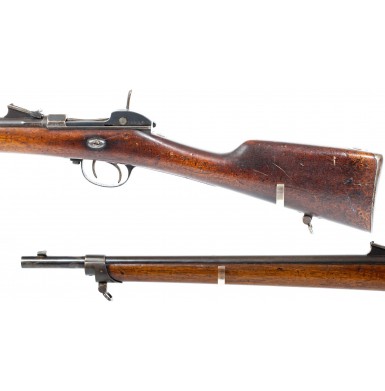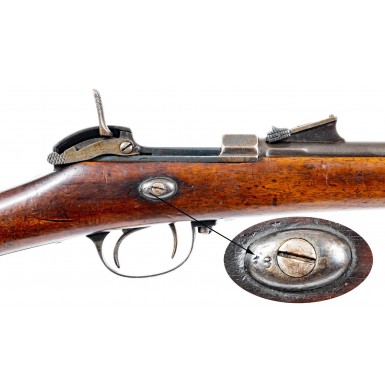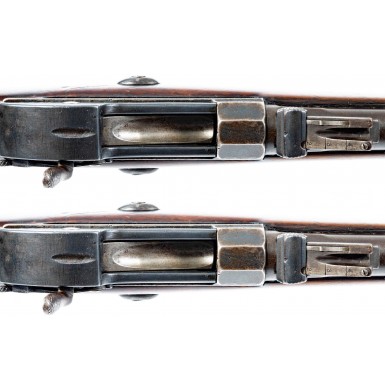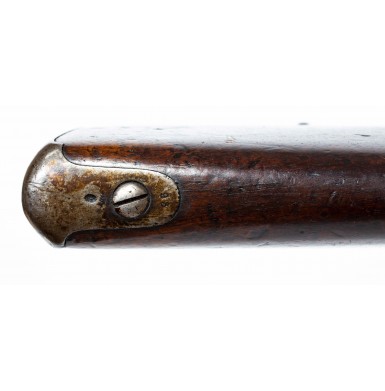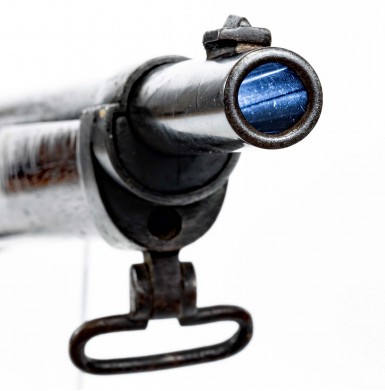Werder M69 Gendarmerie "Lightning" Rifle - Rare
- Product Code: FLA-3554-SOLD
- Availability: Out Of Stock
-
$2,500.00
In 1865, the Bavarian military established a commission to look for a new infantry rifle design to adopt. The commission was specifically looking for a breechloading, self-contained cartridge rifle, preferably one that used the newly developed metal cartridges. The current issue Bavarian infantry rifle at this time was the Model 1858 Podewils rifle, a percussion muzzleloading firearm that was a 13.9mm gun nominally .54 caliber, the same caliber as the Austrian M1854 Lorenz.
The Podewils was an obsolete pattern weapon, considering that the neighboring Prussians had been using the Leichte Perscussions-Gewehr M-1841 or the “Light Percussion Rifle M-1841”for more than two decades. Johann Nikolaus von Dreyse’s invention was known as the Zündnadelgewehr in the German speaking countries, and as the “Needle Gun” around the world. The gun was a bolt action, breechloading rifle that was major technological advancement when compared to the weapons in general use around the world during the 1840s, 1850s and early 1860s. The only downside to the Prussian design was that it was a large bore weapon that utilized a paper cartridge.
In 1866, the Austro-Prussian War erupted, putting the work of the Small Arms Testing Commission on hold. There was no unified Germany at the time and the various German states took sides with the Prussian-lead confederation fighting against a confederation of Austrian-lead states. Bavaria, along with Saxony, Hanover, Wurttemberg, Baden, Hesse-Kastle and several others took the Austrian side, while the Prussian-lead confederation included the states of Brunswick, Mecklenburg-Schwerin, Saxe-Coburg & Gotham, Oldenburg and several others. The war lasted only seven weeks, with the Prussians winning a victory that set the stage for the unification of Germany under Prussian leadership. One of the key factors in the overwhelming lightning-fast victory of the Prussians was their Zündnadelgewehr. The primary lesson taken by the Bavarians at the conclusion of the war was that a new, breechloading rifle had to be adopted immediately.
With the beginning of German unification, many of the German states chose to adopt the Prussian Zündnadelgewehr as an expedient pathway to modernize their small arms inventories. However, Bavaria and their former ally Austria had huge stores of obsolete muzzleloading arms that they chose to modernize and alter to breechloaders as a stop-gap measure while a study of potential infantry rifle designs was undertaken. The Bavarian solution was the adoption of a modified Podewils Rifle, the Model 1858/67, while the Austrian’s adopted the Model 1854/67 Wänzl alteration. The Bavarian system was a Linder-based bolt action, interrupted thread breechloader that still used a percussion cap for ignition, while the Austrian system was similar to the US Trapdoor system, using a self-contained metallic cartridge.
Almost simultaneously, the Bavarian Small Arms Testing Commission began the evaluation of potential cartridge breechloading designs. These included the newly developed Model 1867 Werndl Rifle that their former allies the Austrians were starting to adopt, as well as designs by Vetterli and Mauser. However, the design that was most intriguing to the Bavarians was one put forth by Johann Ludwig Werder. Werder was an engineer and the director of the Cramer-Klett Machine Factory in Nuremberg. This factory was capable of producing some of the highest quality machined metal parts in Bavaria and had been one of the contractors that supplied parts to the Amberg Arsenal for the Podewils breechloading project. One of the members of the Small Arms Committee was none other than Captain Philipp von Podewils, who had not only developed the Podewils Rifle, but was the director of the Amberg Arsenal. Podewils had a good working relationship with Werder and the two clearly respected each other. While it is possible that some other factors that were less than above board may have influenced his opinion of the Werder design, Podewils became a vocal advocate for the Werder design and helped to push the committee towards acceptance of the rifle.
The Weder rifle design was an amazing ergonomic refinement of the single-shot breechloading rifle that allowed for an incredibly fast rate of fire of between 20 and 24 rounds per minute! The action used a Peabody-Martini inspired dropping block but was completely unique. A forward trigger at the front of the triggerguard acted as a release for the breechblock. By pushing this release lever forward, the block dropped under significant spring pressure and ejected the spent cartridge from the chamber. When the soldier inserted a fresh cartridge in the chamber and swept his hand to the rear, he hit an offset cocking lever that closed the action and cocked the firing pin, preparing the rifle to fire. With two simple, fluid motions, the rifle was ready to fire. The amazing speed with which the rifle could be loaded and fired is the why the guns have developed the nickname “Lightning”. Werder’s economy of motion system allowed the press of the forward trigger to accomplish three actions; dropping the block, extracting and then ejecting the cartridge case. Dropping a new cartridge into the chamber and activating the cocking lever made it ready for action again. It was pure genius. The action design was also amazingly modern, with only a single screw securing the action to the rifle. A pair of machined side plates with indexing holes and studs secured all of the internal parts, which were free to pivot without the potential to bind on improperly tensioned internal screws. During the flintlock era Henry Nock’s screwless lock had used this same principle to create a smoother operating, lower friction lock design. The only potential flaw in the Werder design was that the tolerances to which the actions had to be machined meant that they could not be easily produced at the Amberg Arsenal but were something that could be manufactured at the Werder directed Cramer-Klett Machine Factory. In the end, the design was adopted with Cramer-Klett and other contractors capable of high tolerance machine work producing the actions and the Amberg Arsenal assembling the rifles.
Despite the initial acceptance of the Werder design, a late entry from Hiram Berdan, the Berdan II Bolt Action Rifle was submitted and found some favor with the committee. However, the biggest advantage of the Berdan design was a superior metallic cartridge and, in the end, the Berdan cartridge design was adopted in favor of the Werder cartridge design.
As adopted, the Model 1869 Werder “Lightning” Rifle was an 11.5mm single shot, dropping block design that used an 11.5x50R Berdan primed cartridge. The rifle was 52” in overall length with a 35” barrel that was rifled with 4 grooves that initially had a pitch of 1:32” and was eventually changed to 1:36”. The rifle had a saber bayonet lug on the barrel that accepted a Yataghan bladed saber bayonet. At the time of adoption, the Bavarian military had fifty-eight infantry and jaeger regiments and required some 69,600 rifles to re-equip them. There were also an additional thirty-two Landwehr (reserve) regiments that required an additional 28,160 rifles. As a result, an initial order of 100,000 rifles was placed with the Bavarian state arsenal in Amberg. Amazingly, by December of 1870, the arsenal had managed to deliver some 32,414 of the rifles. A cavalry carbine version of the Werder was adopted for the mounted services, as was a pistol version. Both were chambered for a lower powered, shorter version of the Werder cartridge, the 11.5x35R. As the Amberg Arsenal was overloaded trying to produce enough infantry rifles to rearm the army, the Belgian gunmaker August Francotte of Liége was contracted with to produce the new cavalry weapons. As with the Amberg produced Werder arms, the actions for the Francotte carbines were produced by high tolerance machine works like Cramer-Klett and Maschinenbau-Aktiengesellschaft.
In July of 1870, the Franco-Prussian War erupted, continuing until January of 1871. The Bavarians chose to issue their new Werder Rifles piecemeal at the battalion level, which meant that they did not group them together at the regimental, brigade or divisional level. This meant not only a logistical problem in terms of issuing ammunition to regiments that had both the older M1858/67 Podewils and the new Werder rifles, but that the superiority of the Werder’s rate of fire could not really be taken advantage of as not enough of the rifles were ever massed together in combat. The major results of the Prussian victory were a new, unified Germany under Prussian leadership, the taking of French territories of Alsace and Loraine that in many ways helped to set the stage for the First World War and the beginning of the end for the Werder Rifle.
German unification meant that the new country would standardize small arms across the member states. As the Prussian military adopted the Model 1871 Mauser Rifle in 1871, it was expected that all member states would do the same in the coming years. By 1874-75 the Amberg arsenal was tooling up to produce the new M1871 rifle. However, the production of the Werder and rearming of the Bavarian military with the rifle was still going on. As another stop gap measure, while the Werder remained in service and until sufficient M1871s could be produced, it was decided to rechamber the Werder rifles. As noted, their original chambering was 11.5x50R. It was decided to modify these to the chambering of the M1871 rifle, 11.15x60R. This would allow the use of the same ammunition in both guns. The slightly longer and higher pressure Mauser cartridge did not perform well in the tight tolerance Werder designed for a shorter cartridge, and the modification was not popular with the troops in the field. Some of the problems were that extraction became somewhat problematic due to the increased case length and the higher pressure cartridge resulted in more small parts failures in the action.
Interestingly, as the Werder rifle’s short lifespan with the Bavarian army was coming to an abrupt end, the Bavarian police sought to obtain the new Werder Rifles. In the early 1870s, the Landpolizei (Gendarmerie or “rural police”) were still armed with the obsolete, muzzleloading Model 1844 percussion smoothbore musket. The Gendarmerie literally demanded that they receive the new Werder rifles in 1873, and within a year they had been completely rearmed. The new Gendarmerie Werder Rifle was based upon the Werder Cavalry Carbine design. The carbine had added a safety system that was considered essential on horseback but was thought unnecessary for the infantryman. The new Gendarmerie rifle used the cavalry carbine style receiver with safety but used a medium length barrel. The 35” barrel of the infantry rifle was considered too long and the 15 ½” carbine barrel was too short. The Gendarmerie used a 21 ½” barrel and was designed to accept a socket bayonet that was similar to the older Podewils bayonet with a helical mortise cut in the socket, inspired by the Austrian bayonets of the 1850s. As the Amberg Arsenal was overwhelmed with the modification of M1869 Werder Rifles and tooling up to produce M1871 Mauser Rifles, the Bavarians again looked to August Francotte to produce the new guns. Adopted as the Model 69 Gendarmerie Rifle (some sources call it a M1873 and some M1874), 2,639 of the rifles were ordered from Francotte. As had been the practice from the beginning with infantry rifles, specialized contractors produced the actions, which were assembled by Amberg. In this case Maschinenbau-Aktiengesellschaft of Nuremberg produced the actions which were supplied to Francotte who then produced the guns. After assembly the guns were sent to Amberg for inspection. By October of 1874, all 2,639 rifles had been delivered and the Gendarmerie had been rearmed. That same year an additional 600 rifles were ordered to equip the Zollwache (customs officers) as well as 100 more rifles for the General Customs Administration. In 1875, 50 more rifles were ordered for the rural police, bringing the total production of the Gendarmerie rifle to 3,389.
In 1882, 698 of the existing stocks of Gendarmerie rifles were modified for use by the Grenzschutwache (Boarder Police). These guns had the rear sights altered from a 200-yard minimum setting to a 50-yard setting and were further modified to accept a hanger style sword bayonet, known as a Hirschfänger, rather than the socket bayonet. Amazingly, despite the adoption of the Model 1888 Commission Rifle, and eventually the Model 1898 Mauser, the Gendarmerie continued to use their M1873 Rifles through the World War I period and into the post-war period. It was not until the conclusion of the First World War that the Bavarian Gendarmerie started to receive new arms, and it was around 1924 before the Werder Gendarmerie Rifle was completely withdrawn from service, after some fifty years of use. Due to the half century of use, when these scarce guns are found on the collector market they are rarely found in nice condition.
Offered here is a very scarce Model 1869 Werder “Lightning” Gendarmerie Rifle. The rifle remains in VERY GOOD+ to NEAR FINE condition, somewhat amazing considering the fifty year service life that these rifles had. The rifle is serial number 1193, and the matching number appears on the left side of the barrel, chamber and receiver, as well as inside the triggerguard. The external small parts are all marked with the last two numbers of this serial number, 93, with the exception of a couple. The two escutcheons that surround the action retention screws are numbered 28, and a couple of the screws are worn with no discernable numbers on their heads. The action is numbered internally with its own assembly numbers, in this case 2591 and is all matching. The action is also marked CK, indicating it was produced by Cramer-Klett. The rear of the receiver is stamped 1874 twice, once indicating the year of production and the other possibly indicating the “model” designation. The top of the barrel is marked A FRANCOTTE A LIÉGE and a Liége proof mark is present on the left of the breech. The top of the receiver is stamped GF, the inspection mark of the Amberg Arsenal, indicating that the gun had been viewed at the Gewehrfabrik (rifle factory).
As noted, the gun remains in VERY GOOD+ to NEAR FINE condition. It retains about 30% of its original blued finish, most of which is on the receiver. Most of the barrel retains only traces of finish and has a mostly evenly oxidized plum brown patina. The muzzle area, however, does retain some nice blue. The metal is mostly smooth with some scattered oxidized surface roughness and pinpricking here and there, but no real pitting to speak off. The action of the rifle functions perfectly and all aspects of the system operate correctly, including the safety. The bore is in VERY GOOD condition and is mostly bright with some evenly distributed frosting, scattered oxidation and some small areas of very light pitting. The rifle retains its correct, original 200 to 500 yard rear sight that remains fully functional. This is one of the 2,691 rifles that was not altered for Boarder Guard use. The original combination front sight and socket bayonet lug remains in place as well. Both original sling swivels are also present. Only the cleaning rod is missing from the gun, it is otherwise 100% complete. The stock has a nice, uncleaned appearance and remains in VERY GOOD+ to NEAR FINE condition as well. The stock is solid, full-length and free of any breaks, cracks or repairs. The stock shows numerous bumps, dings, scuffs and mars, but not abuse. All of the wear is to be expected of a paramilitary police rifle that saw half a century of service.
Overall this is a very nice example of a scarce Model 1869 Werder “Lightning” Gendarmerie Rifle. With only 3,389 produced, these are very rare guns. As nearly 700 were subsequently modified for Boarder Guard use, the number of original, unaltered guns is even smaller. The Werder is certainly a very interesting and intriguing design and a unique bridge between the converted muzzleloaders of Bavaria and the Mauser rifles. It is also unique in that the Werder had one of the shortest periods of use with the Bavarian military, while one of the longest periods of use with the Gendarmerie! This is a scarce rifle that belongs in any advanced collection of European cartridge rifles of the 19thcentury and would also be at home as a starting point for a collection of German police small arms that would run through WWII era police marked pistols. These guns do not come up for sale very often and the only one I could find on the market currently is priced $1,000 higher than this very nice example.
SOLD






